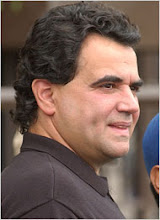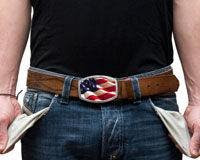Posted: 7:28 PM Dec 30, 2009
Freedom's Flight is a beautiful thoroughbred with an impressive pedigree. His bloodlines can be traced to two of the greatest race horses of all time, Seattle Slew and Secretariat.
Reporter: CNN
Font Size: Miami, Florida (CNN) -- Freedom's Flight is a beautiful thoroughbred with an impressive pedigree. His bloodlines can be traced to two of the greatest race horses of all time, Seattle Slew and Secretariat.
But, unlike his kinship, Freedom's Flight's racing career ended before it had even started. It was almost two years ago when the thoroughbred's leg snapped right out of the gate at Miami's Gulfstream race track. The animal's days as a cherished racehorse came to an abrupt end.
"He came from the famous Clairborne farm and ended up on one of the worst farms in America," says new owner Richard "Kudo" Couto.
That "worst" farm in America turned out to be an illegal slaughter farm in Miami-Dade County, Florida. Couto, working for the South Florida Society for the Prevention of Cruelty to Animals, participated in a raid on the farm and rescued Freedom's Flight. The timing of that rescue may have saved Freedom's Flight's life. The horse was limping around on his broken leg, he had sores on his body, and you could see his bones protruding from his dirty coat.
Some 18 months since his rescue, Freedom's Flight looks more like the stunning race horse that was worth thousands of dollars than the injured horse that was sold for $50 to an illegal slaughter farm.
"Prior to his rescue, I didn't know that illegal slaughter farms existed in the country -- let alone under my nose in my own county," says Couto.
This new knowledge has motivated Couto. "It really made me buckle down and basically dedicate my life to shut this industry down. It's become personal for me," he says.
Couto suspects that there are more than 100 illegal slaughterhouses in the area. There is only one slaughterhouse that operates legally, Cabrera's, and there the United States Department of Agriculture inspectors are housed on its property.
Many of these illegal places are concentrated in an unincorporated area of Miami-Dade County. The roads are dirt, the vegetation thick and uninviting. This is the western fringe of Miami along the rim of the Everglades, an area considered a sort of no-man's land.
There are signs in English and in Spanish advertising animals for sale. Tarps are put up to hide what is behind the chain link fences, but most of these businesses are open to the public. "You don't have to be a rocket scientist after walking the properties and seeing the dead carcasses, the guts in the trash bins, the slaughter tables, the knives -- all of the tools of running this type of operation is right in front of you," says Couto.
CNN visited several of these establishments. At one location where a pig was being carved on one table and a chicken on the other, we asked to film on the property. "This slaughterhouse isn't as clean as you can see, try Cabrera's," said the unidentified man behind the slaughter table. Like several places we visited there was blood on the floor, dirty butcher knives and an overwhelming stench.
Couto says it isn't the slaughtering of animals that has put him on this mission. It's the way the animals are treated.
"These animals are living in extreme filth. They're beaten. The way they're slaughtered is inhumane," says Couto.
Couto has been on a one-man crusade to shut down illegal slaughterhouses that are operating without licenses and without oversight by the health or agriculture departments. He was first exposed to what he calls the "dark underbelly" of the area when, with the Florida SPCA, he was investigating the slaughter of horses for their meat.
Motivated by Freedom's Flight, Couto left the South Florida SPCA to form his own organization called ARM -- Animal Recovery Mission.
For the past year he has used a video camera to collect evidence. Couto has simply walked right into dozens of slaughterhouses and has filmed bloody slaughter tables.
"I go in acting like a customer," he says, "I ask them, 'How much for the pig?' And they'll say 120 dollars. 'How much for the kill?' '20 bucks. We'll slaughter it for you for 20 bucks.' It's that easy."
One local agency that spends a lot of time in the area because sections of it are considered protected wetland is the Miami-Dade Department of Environmental Resources Management. Carlos Espinosa is in charge of enforcing the county's environmental regulations.
"When we come across other issues relating to other departments, we pass that information on to other departments," says Espinosa.
Couto took his story and his videos to every local agency he could think of with oversight responsibility. He tried to set up a task force with agencies in charge of violations such as animal cruelty, illegal structures, illegal businesses, permit problems and zoning issues. A sign-in sheet from one of these meetings shows many of the agencies attended the meeting, but Couto says nothing came of it.
CNN contacted Miami-Dade Animal Services Department, an agency that had a representative at that meeting. Spokesperson Xiomara Mordcovich said the agency does not deal with issues involving farm animals and directed us to the Miami-Dade Police Department.
The Police Department declined an interview. "We are not actively investigating any incidents involving illegal slaughterhouses," the department said in an e-mail. Then it referred us back to Animal Services and also to the code compliance department.
Charles Danger, director of the Miami-Dade Building and Neighborhood Compliance Department, admits that it was because of Couto's persistence that it is now putting together a multi-agency task force he called "Operation Miss Piggy and Mr. Ed."
According to Danger, part of the reason nothing has been done to clean up this area is because of fear for the safety of inspectors.
"Every time we go in there, we have to go in there with the police -- and even the police don't want to go in there," says Danger.
Danger says the Miami-Dade Police Department is now on the new task force, which also includes agencies such as the state health department and the U.S. Department of Agriculture. "It comes from a lot of years of illegal operation. We have to do it together because it's not going to be easy," says Danger.
One organization that will keep tabs on the progress is the Animal Recovery Mission. Couto says he will not go away quietly. He calls his mission "redemption and revenge for Freedom's Flight and what he went through."
Thursday, December 31, 2009
Tuesday, December 15, 2009
NYRA announces anti-slaughter policy
Well its about time! NYS has thee most lucrative breeding incentives in the world,....it is the least they can do.
SARATOGA SPRINGS - The New York Racing Association is cracking the whip on owners and trainers who sell their horses to slaughter.
NYRA announced a new policy Thursday -- a month after NewsChannel 13 reported that the organization didn't have written rules regarding slaughter.
While they're racing and winning, they often live the good life. After they've lost their value, it's possible for racehorses to end up at slaughterhouses -- strung up, throats slashed and allowed to bleed out.
More Information:
NYRA Details Anti-Slaughter Policy
Related Stories:
Part 1: Home stretch for thoroughbreds
Part 2: Life after the track
The movement to make sure racehorses don't end up slaughtered for food gained momentum when NYRA adopted strict new no-slaughter rules.
The new NYRA policy says any owner or trainer who sells a horse to slaughter will lose his barn privileges permanently.
"Horse slaughter will not be tolerated and those participating in this practice, either knowingly or for lack of due diligence, will not be welcome at Aqueduct, Belmont Park, or Saratoga," NYRA President and CEO Charles Hayward said in a statement.
This policy is a personal victory for John Hendrickson of Marylou Whitney Stables. Shortly after NewsChannel 13 told the story of racehorse slaughter in late October, Hendrickson took the issue to his fellow NYRA board members.
"They were very receptive. There's nobody that's for slaughter," Hendrickson said.
According to the humane society, up to 20 percent of all thoroughbreds end up slaughtered. The thoroughbred retirement foundation works to save racehorses and welcomes NYRA's new no-tolerance policy.
"This sends the absolute right message to owners and breeders, saying we have to think about these horses for their whole lives, not just when they're on the track trying to make money for us," said Diana Pikulski of the Thoroughbred Retirement Foundation.
Click on title above for original article and video;
http://www.topix.com/forum/sports/horse-racing/TV5L6UAUNQ9H9O40K
SARATOGA SPRINGS - The New York Racing Association is cracking the whip on owners and trainers who sell their horses to slaughter.
NYRA announced a new policy Thursday -- a month after NewsChannel 13 reported that the organization didn't have written rules regarding slaughter.
While they're racing and winning, they often live the good life. After they've lost their value, it's possible for racehorses to end up at slaughterhouses -- strung up, throats slashed and allowed to bleed out.
More Information:
NYRA Details Anti-Slaughter Policy
Related Stories:
Part 1: Home stretch for thoroughbreds
Part 2: Life after the track
The movement to make sure racehorses don't end up slaughtered for food gained momentum when NYRA adopted strict new no-slaughter rules.
The new NYRA policy says any owner or trainer who sells a horse to slaughter will lose his barn privileges permanently.
"Horse slaughter will not be tolerated and those participating in this practice, either knowingly or for lack of due diligence, will not be welcome at Aqueduct, Belmont Park, or Saratoga," NYRA President and CEO Charles Hayward said in a statement.
This policy is a personal victory for John Hendrickson of Marylou Whitney Stables. Shortly after NewsChannel 13 told the story of racehorse slaughter in late October, Hendrickson took the issue to his fellow NYRA board members.
"They were very receptive. There's nobody that's for slaughter," Hendrickson said.
According to the humane society, up to 20 percent of all thoroughbreds end up slaughtered. The thoroughbred retirement foundation works to save racehorses and welcomes NYRA's new no-tolerance policy.
"This sends the absolute right message to owners and breeders, saying we have to think about these horses for their whole lives, not just when they're on the track trying to make money for us," said Diana Pikulski of the Thoroughbred Retirement Foundation.
Click on title above for original article and video;
http://www.topix.com/forum/sports/horse-racing/TV5L6UAUNQ9H9O40K
Monday, December 7, 2009
Ohio Standardbred Barn Fire Kills 2 Men, 42 Horses

Horse owners stood stunned as they watched heavy machinery peel back the metal roof of the collapsed structure so firefighters could sift through the debris and extinguish what remained of the blaze. -- PHOTO: AP
LEBANON (Ohio) - A FIRE ripped through a horse barn at a county fairgrounds Saturday in southwest Ohio, killing two men and 43 horses, authorities said.
The barn roof had already collapsed by the time firefighters arrived at the Warren County Fairgrounds early Saturday morning, according to Capt. Krista Wyatt of the Lebanon Fire Department.
The bodies of the men were pulled from the barn and were badly burned, said Shane Cartmill, a spokesman for the Ohio State Fire Marshal. Cartmill was unable to confirm the identities late Saturday.
A horse owner identified the men as Ronnie Williams and James Edwards, both trainers at a harness racing racetrack based at the fairgrounds. Victor Gray, who owned three of the horses that died, said he'd known Williams nearly 40 years. Lamar Moody, lead trainer at Lebanon Raceway, said two of his employees were not accounted for.
No one was supposed to be in the stables overnight and it was not clear if the two men killed were working early or sleeping in the barn. 'It's a terrible situation,' said Gray. 'This is something that didn't have to happen.' The cause of the blaze was under investigation, but state fire investigators say they have ruled out criminal intent.
Horse owners stood stunned as they watched heavy machinery peel back the metal roof of the collapsed structure so firefighters could sift through the debris and extinguish what remained of the blaze. The horses weren't pets but nonetheless were 'part of the family, our kids,' Gray said. 'We loved those horses.' In 1988, a fire in a similar part of the county-owned racetrack and fairgrounds killed 35 horses. No one was killed in that fire. -- AP
LEBANON (Ohio) - A FIRE ripped through a horse barn at a county fairgrounds Saturday in southwest Ohio, killing two men and 43 horses, authorities said.
The barn roof had already collapsed by the time firefighters arrived at the Warren County Fairgrounds early Saturday morning, according to Capt. Krista Wyatt of the Lebanon Fire Department.
The bodies of the men were pulled from the barn and were badly burned, said Shane Cartmill, a spokesman for the Ohio State Fire Marshal. Cartmill was unable to confirm the identities late Saturday.
A horse owner identified the men as Ronnie Williams and James Edwards, both trainers at a harness racing racetrack based at the fairgrounds. Victor Gray, who owned three of the horses that died, said he'd known Williams nearly 40 years. Lamar Moody, lead trainer at Lebanon Raceway, said two of his employees were not accounted for.
No one was supposed to be in the stables overnight and it was not clear if the two men killed were working early or sleeping in the barn. 'It's a terrible situation,' said Gray. 'This is something that didn't have to happen.' The cause of the blaze was under investigation, but state fire investigators say they have ruled out criminal intent.
Horse owners stood stunned as they watched heavy machinery peel back the metal roof of the collapsed structure so firefighters could sift through the debris and extinguish what remained of the blaze. The horses weren't pets but nonetheless were 'part of the family, our kids,' Gray said. 'We loved those horses.' In 1988, a fire in a similar part of the county-owned racetrack and fairgrounds killed 35 horses. No one was killed in that fire. -- AP
Subscribe to:
Posts (Atom)
















